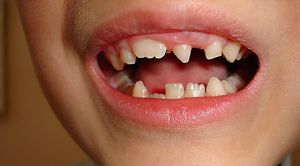 One of the most common dental pathologies is abnormal development of the shape and size of the teeth. Most often, these problems are innate.
One of the most common dental pathologies is abnormal development of the shape and size of the teeth. Most often, these problems are innate.
In addition, the anomalies of the teeth form are accompanied by physiological disorders: there are difficulties in speech, problems with food processing.
These problems have a negative impact on human life and in the future can lead to the development of serious pathologies. That is why all dental abnormalities must be corrected in a timely manner. In most cases, deformations of the enamel occur against the background of hypoplasia.
Contents
- About systemic hypoplasia
- Provoking factors
- Formal anomalies
- Anomalies that develop due to other causes
- Correction methods
- Preventive measures
- Possible consequences
About systemic hypoplasia
Systemic hypoplasia is considered one of the most common abnormalities characterized by underdevelopment of enamel. In most cases, the disease manifests itself on the milk teeth, it is at this time that the destruction penetrates into the deeper layers and can capture the dentin.
Often, improper or prolonged treatment of hypoplasia in childhood can lead to tooth loss. This deviation at the moment is found in every 5 children. In order to reduce the risk of hypoplasia, it is necessary to follow preventive measures, minimize the causes of pathology.
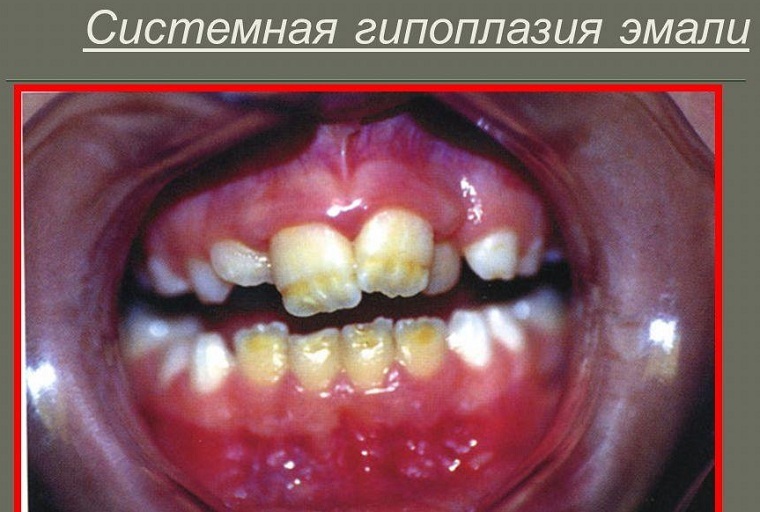
Provoking factors
Embryonic development plays a huge role in the further formation of teeth, their shape and size. That is why many dentists believe that the main basis for the initial development of dental abnormalities is the problematic bearing of the child. Causes associated with embryonic development:
- genetic factor;
- intensive toxicosis;
- acute course of chronic diseases during pregnancy;
- vitamin deficiency;
- the use of alcoholic and narcotic products;
- infectious and viral diseases.
In addition, the development of systemic hypoplasia is also affected by the process of birth. Possible causes of the formation of pathology:
- birth of a premature baby;
- severe birth injury;
- preventing the process of childbearing chronic gynecological diseases.
Anomalies of the form
Systemic hypoplasia of the enamel has a huge number of varieties that differ in external manifestations of the disease:
- Teaner's teeth - this pathology, most often, affects molars. This variety appears in the form of white spots on the enamel, which in time can darken. In addition, deformations occur, and mounds appear.
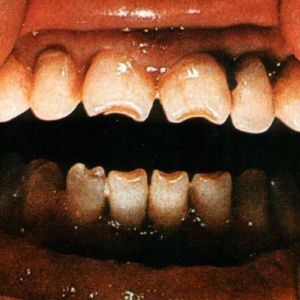
- Pfluger teeth are characterized by a cone-shaped "sixes", that is, the first molars. The cutting edge for this anomaly is much less than the base. Deviation, as a rule, occurs against the background of infection of syphilis.
- Getschinson teeth ( pictured right) is one of the common varieties affecting the incisors, which acquire a barrel shape. A distinctive feature of this type - the cutting edge resembles a crescent moon.
- Fournier teeth are very similar to the Hutchinson anomaly, but in this case there is no pathological cutting edge. It was believed for a long time that these anomalies are signs of congenital syphilis, but the fact was false.
- Spine teeth is a pathology characterized by genetic mutations. In this case, the teeth are in the form of a spine.
Anomalies that develop due to other causes
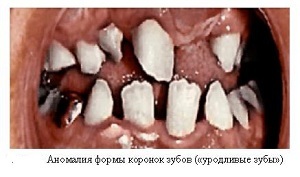 In addition to the presented pathologies, there are other dentoalveolar anomalies that develop against a background of other factors. Quite often there are teeth that are fused at the base or in the crown, most often such an anomaly manifests itself on the central and lateral incisors.
In addition to the presented pathologies, there are other dentoalveolar anomalies that develop against a background of other factors. Quite often there are teeth that are fused at the base or in the crown, most often such an anomaly manifests itself on the central and lateral incisors.
Because of genetic mutations, there are other pathologies - obvious curvature, increase or decrease incisors. These anomalies of development entail not only aesthetic defects, but also physiological problems. That is why any tooth-jaw pathology must be corrected on time.
Correction methods
Therapy and correction of all forms of hypoplasia depends on the stage of the development of the disease. In the early stages, as a rule, several remineralization procedures are enough. At subsequent stages, the dentist selects the components of therapy, depending on the degree of enamel damage.
Basic methods of treatment of enamel repair:
- Remineralization of is carried out at the stage of appearance of white spots, small damages of enamel. The method implies the use of special mineralizing drugs with the inclusion of physiotherapy.
- Sealing is necessary when the enamel is damaged already sufficiently. The procedure includes cleansing of enamel, treatment with special preparations and restoration with the help of a seal.
- Veneers, Composites, Lumineers is a modern method, involving the use of special plates that are attached to the tooth with the help of a special glue, preserving its aesthetic appearance.
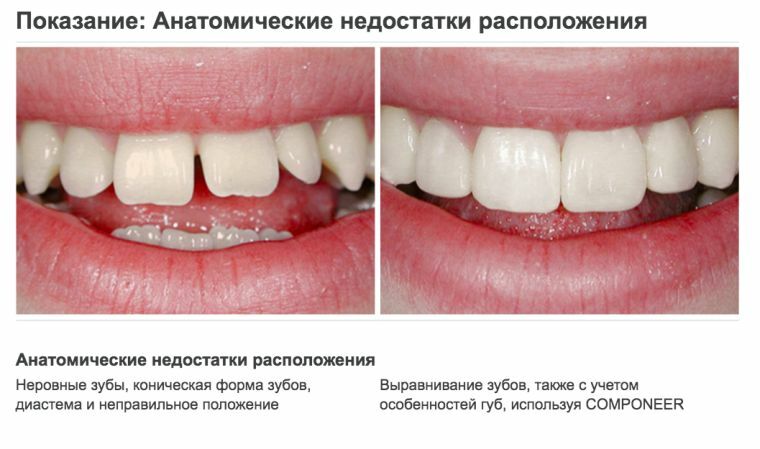
If the tooth is damaged significantly, dentists recommend its removal, and in its place an implant is installed. In order to prevent tooth loss, treatment should be started as early as possible.
Prophylactic measures
Since the main cause of hypoplasia is considered to be problems in embryonic development, a huge role is played by the condition of a woman during the period of gestation. It is at this time that it is important to follow a set of preventive recommendations:
- follow the rules of healthy eating;

- to exclude from the course of treatment strong medications that affect the development of the fetus;
- minimize the occurrence of acute periods of chronic diseases;
- use complex vitamins.
Following these rules significantly reduces the risk of development of hypoplasia in the teeth of the baby, but in order to prevent the development of pathology to the indigenous, it is necessary:
- to comply with complex hygiene;
- to eat healthy and vitamin-rich food;
- regularly undergo preventive dental examinations;
- to avoid injuring the enamel;
- in time to treat dental diseases.
Observing the above recommendations, the risk of forming anomalies of enamel is minimized.
Possible consequences of
Serious complications can be expected if there is no or incorrect treatment. As the progressive disease significantly impairs the protective properties of the enamel, the following negative consequences result:
- a significant increase in sensitivity;
- development of carious disease;
- occurrence of a pathological occlusion;
- increase in the rate of enamel wear;
- , it becomes necessary to remove the tooth, since deep tissues are affected.
It should be noted that the diseases of the oral cavity affect the state of the body as a whole. In particular, excessive destruction of enamel often leads to the formation of chronic diseases of the digestive system.
Hypoplasia is a common and rather serious dental disease that, if not properly treated, can lead to tooth loss and the development of internal diseases.
In this regard, it is necessary to begin treatment at the first symptoms of this disease, and to prevent development follow the preventive recommendations.
